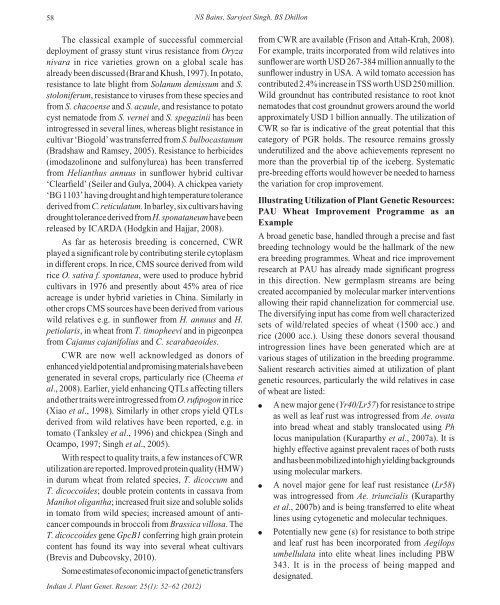indian society of plant genetic resources - Bioversity International
indian society of plant genetic resources - Bioversity International
indian society of plant genetic resources - Bioversity International
Create successful ePaper yourself
Turn your PDF publications into a flip-book with our unique Google optimized e-Paper software.
58<br />
The classical example <strong>of</strong> successful commercial<br />
deployment <strong>of</strong> grassy stunt virus resistance from Oryza<br />
nivara in rice varieties grown on a global scale has<br />
already been discussed (Brar and Khush, 1997). In potato,<br />
resistance to late blight from Solanum demissum and S.<br />
stoloniferum, resistance to viruses from these species and<br />
from S. chacoense and S. acaule, and resistance to potato<br />
cyst nematode from S. vernei and S. spegazinii has been<br />
introgressed in several lines, whereas blight resistance in<br />
cultivar ‘Biogold’ was transferred from S. bulbocastanum<br />
(Bradshaw and Ramsey, 2005). Resistance to herbicides<br />
(imodazolinone and sulfonylurea) has been transferred<br />
from Helianthus annuus in sunfl ower hybrid cultivar<br />
‘Clearfi eld’ (Seiler and Gulya, 2004). A chickpea variety<br />
‘BG 1103’ having drought and high temperature tolerance<br />
derived from C. reticulatum. In barley, six cultivars having<br />
drought tolerance derived from H. sponataneum have been<br />
released by ICARDA (Hodgkin and Hajjar, 2008).<br />
As far as heterosis breeding is concerned, CWR<br />
played a signifi cant role by contributing sterile cytoplasm<br />
in different crops. In rice, CMS source derived from wild<br />
rice O. sativa f. spontanea, were used to produce hybrid<br />
cultivars in 1976 and presently about 45% area <strong>of</strong> rice<br />
acreage is under hybrid varieties in China. Similarly in<br />
other crops CMS sources have been derived from various<br />
wild relatives e.g. in sunfl ower from H. annuus and H.<br />
petiolaris, in wheat from T. timopheevi and in pigeonpea<br />
from Cajanus cajanifolius and C. scarabaeoides.<br />
CWR are now well acknowledged as donors <strong>of</strong><br />
enhanced yield potential and promising materials have been<br />
generated in several crops, particularly rice (Cheema et<br />
al., 2008). Earlier, yield enhancing QTLs affecting tillers<br />
and other traits were introgressed from O. rufi pogon in rice<br />
(Xiao et al., 1998). Similarly in other crops yield QTLs<br />
derived from wild relatives have been reported, e.g. in<br />
tomato (Tanksley et al., 1996) and chickpea (Singh and<br />
Ocampo, 1997; Singh et al., 2005).<br />
With respect to quality traits, a few instances <strong>of</strong> CWR<br />
utilization are reported. Improved protein quality (HMW)<br />
in durum wheat from related species, T. dicoccum and<br />
T. dicoccoides; double protein contents in cassava from<br />
Manihot oligantha; increased fruit size and soluble solids<br />
in tomato from wild species; increased amount <strong>of</strong> anticancer<br />
compounds in broccoli from Brassica villosa. The<br />
T. dicoccoides gene GpcB1 conferring high grain protein<br />
content has found its way into several wheat cultivars<br />
(Brevis and Dubcovsky, 2010).<br />
Some estimates <strong>of</strong> economic impact <strong>of</strong> <strong>genetic</strong> transfers<br />
Indian J. Plant Genet. Resour. 25(1): 52–62 (2012)<br />
NS Bains, Sarvjeet Singh, BS Dhillon<br />
from CWR are available (Frison and Attah-Krah, 2008).<br />
For example, traits incorporated from wild relatives into<br />
sunfl ower are worth USD 267-384 million annually to the<br />
sunfl ower industry in USA. A wild tomato accession has<br />
contributed 2.4% increase in TSS worth USD 250 million.<br />
Wild groundnut has contributed resistance to root knot<br />
nematodes that cost groundnut growers around the world<br />
approximately USD 1 billion annually. The utilization <strong>of</strong><br />
CWR so far is indicative <strong>of</strong> the great potential that this<br />
category <strong>of</strong> PGR holds. The resource remains grossly<br />
underutilized and the above achievements represent no<br />
more than the proverbial tip <strong>of</strong> the iceberg. Systematic<br />
pre-breeding efforts would however be needed to harness<br />
the variation for crop improvement.<br />
Illustrating Utilization <strong>of</strong> Plant Genetic Resources:<br />
PAU Wheat Improvement Programme as an<br />
Example<br />
A broad <strong>genetic</strong> base, handled through a precise and fast<br />
breeding technology would be the hallmark <strong>of</strong> the new<br />
era breeding programmes. Wheat and rice improvement<br />
research at PAU has already made signifi cant progress<br />
in this direction. New germplasm streams are being<br />
created accompanied by molecular marker interventions<br />
allowing their rapid channelization for commercial use.<br />
The diversifying input has come from well characterized<br />
sets <strong>of</strong> wild/related species <strong>of</strong> wheat (1500 acc.) and<br />
rice (2000 acc.). Using these donors several thousand<br />
introgression lines have been generated which are at<br />
various stages <strong>of</strong> utilization in the breeding programme.<br />
Salient research activities aimed at utilization <strong>of</strong> <strong>plant</strong><br />
<strong>genetic</strong> <strong>resources</strong>, particularly the wild relatives in case<br />
<strong>of</strong> wheat are listed:<br />
● A new major gene (Yr40/Lr57) for resistance to stripe<br />
as well as leaf rust was introgressed from Ae. ovata<br />
into bread wheat and stably translocated using Ph<br />
locus manipulation (Kuraparthy et al., 2007a). It is<br />
highly effective against prevalent races <strong>of</strong> both rusts<br />
and has been mobilized into high yielding backgrounds<br />
using molecular markers.<br />
● A novel major gene for leaf rust resistance (Lr58)<br />
was introgressed from Ae. triuncialis (Kuraparthy<br />
et al., 2007b) and is being transferred to elite wheat<br />
lines using cyto<strong>genetic</strong> and molecular techniques.<br />
● Potentially new gene (s) for resistance to both stripe<br />
and leaf rust has been incorporated from Aegilops<br />
umbellulata into elite wheat lines including PBW<br />
343. It is in the process <strong>of</strong> being mapped and<br />
designated.

















